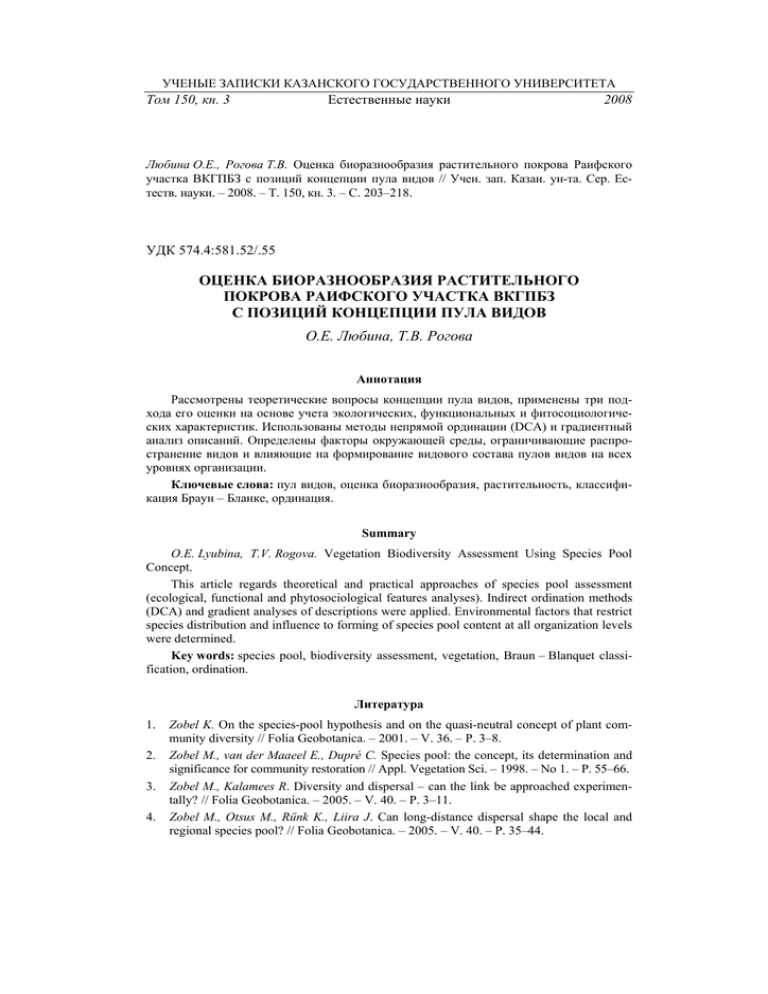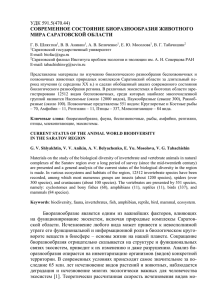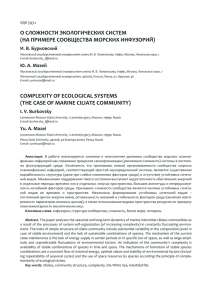оценка биоразнообразия растительного покрова раифского
advertisement

УЧЕНЫЕ ЗАПИСКИ КАЗАНСКОГО ГОСУДАРСТВЕННОГО УНИВЕРСИТЕТА Том 150, кн. 3 Естественные науки 2008 Любина О.Е., Рогова Т.В. Оценка биоразнообразия растительного покрова Раифского участка ВКГПБЗ с позиций концепции пула видов // Учен. зап. Казан. ун-та. Сер. Естеств. науки. – 2008. – Т. 150, кн. 3. – С. 203–218. УДК 574.4:581.52/.55 ОЦЕНКА БИОРАЗНООБРАЗИЯ РАСТИТЕЛЬНОГО ПОКРОВА РАИФСКОГО УЧАСТКА ВКГПБЗ С ПОЗИЦИЙ КОНЦЕПЦИИ ПУЛА ВИДОВ О.Е. Любина, Т.В. Рогова Аннотация Рассмотрены теоретические вопросы концепции пула видов, применены три подхода его оценки на основе учета экологических, функциональных и фитосоциологических характеристик. Использованы методы непрямой ординации (DCA) и градиентный анализ описаний. Определены факторы окружающей среды, ограничивающие распространение видов и влияющие на формирование видового состава пулов видов на всех уровнях организации. Ключевые слова: пул видов, оценка биоразнообразия, растительность, классификация Браун – Бланке, ординация. Summary O.E. Lyubina, T.V. Rogova. Vegetation Biodiversity Assessment Using Species Pool Concept. This article regards theoretical and practical approaches of species pool assessment (ecological, functional and phytosociological features analyses). Indirect ordination methods (DCA) and gradient analyses of descriptions were applied. Environmental factors that restrict species distribution and influence to forming of species pool content at all organization levels were determined. Key words: species pool, biodiversity assessment, vegetation, Braun – Blanquet classification, ordination. Литература 1. 2. 3. 4. Zobel K. On the species-pool hypothesis and on the quasi-neutral concept of plant community diversity // Folia Geobotanica. – 2001. – V. 36. – P. 3–8. Zobel M., van der Maaeel E., Dupré C. Species pool: the concept, its determination and significance for community restoration // Appl. Vegetation Sci. – 1998. – No 1. – P. 55–66. Zobel M., Kalamees R. Diversity and dispersal – can the link be approached experimentally? // Folia Geobotanica. – 2005. – V. 40. – P. 3–11. Zobel M., Otsus M., Rünk K., Liira J. Can long-distance dispersal shape the local and regional species pool? // Folia Geobotanica. – 2005. – V. 40. – P. 35–44. 5. 6. 7. 8. 9. 10. 11. 12. 13. 14. 15. 16. 17. 18. 19. 20. 21. 22. 23. 24. Maarel E. Biodiversity: from babel to biosphere management. Special Features in Biosystematics and Biodiversity 2. – Uppsala: Opulus Press, 1997. – 60 р. Grace J.B. Difficulties with estimating and interpreting species pools and the implications for understanding patterns of diversity // Folia Geobotanica. – 2001. – V. 36. – P. 71–83. Palmer M.W. Extending the Quasi-neutral concept // Folia Geobotanica. – 2001. – V. 36. – P. 25–33. Butaye J., Jacquemyn H., Honnay O., Hermy M. The species pool concept applied to forests in a fragmented landscape: dispersal limitation versus habitat limitation // J. Vegetation Sci. – 2001. – V. 13, No 1. – Р. 27–34. Hillebrand H., Blenckner Th. Regional and local impact on species diversity – from pattern to processes // Oecologia. – 2002. – V. 132. – P. 479–491. Schamp B.S., Aarssen L.W., Lee H. Local plant species richness increases with regional habitat commonness across a gradient of forest productivity // Folia Geobotanica. – 2003. – V. 38. – P. 273–280. Lepš J. Species-pool hypothesis: limits to its testing // Folia Geobotanica. – 2001. – V. 36. – P. 45–52. During H. J., Lloret F. The species-pool hypothesis from a bryological perspective // Folia Geobotanica. – 2001. – V. 36. – P. 63–70. Sándor B., Ittzés P. Local richness-species pool ratio: a consequence of the species-area relationship // Folia Geobotanica. – 2001. – V. 36. – P. 9–23. Rydin H., Barber K.E. Long-term and fine-scale coexistence of closely related species // Folia Geobotanica. – 2001. – V. 36. – P. 53–61. Bastow J.W., Anderson B.J. Species-pool relations: like a wooden light bulb? // Folia Geobotanica. – 2001. – V. 36. – P. 35–44. Ozinga W.A., Schaminée J.H.J., Bekker R.M., Bonn S., Poschlod P., Tackenberg O., Bakker J., van Groenendael J.M. Predictability of plant species composition from environmental conditions is constrained by dispersal limitation // Oiko. – 2005. – V. 108. – P. 555–561. Herben T. Species pool size and invisibility of island communities: a null model of sampling effects // Ecology Lett. – 2005. – No 8. – P. 909–917. Schwilk D.W., Ackerly D.D. Limiting similarity and functional diversity along environmental gradients // Ecology Lett. – 2005. – No 8. – P. 272–281. Peet R.K., Fridley J.D., Gramling J.M. Variation in species richness and species pool size across a pH gradient in forest of the southern Blue Ridge Mountains // Folia Geobotanica. – 2003. – V. 38. – P. 391–401. Mcpeek M.A., Brown J.M. Building a Regional Species Pool: Diversification of the Enallagma Damselflies In Eastern North America // Ecology. – 2000. – V. 81, No 4. – P. 904–920. Akatov V.V., Chefranov S.G., Akatova T.V. The species pool hypothesis: the necessity to shift emphasis // Zhurnal obshei biologii. – 2002. – V. 63, No 2. – P. 112–121. Weitz J.S., Rothman D.H. Scale-dependence of resource-biodiversity relationships // J. Theor. Biol. – 2003. – V. 225. –P. 205–214. Turner W.R., Tjørve E. Scale-dependence in species-area relationships // Ecography. – 2005. – V. 28. – P. 721–730. Renöfält B.M., Nilsson C., Jansson R. Spatial and temporal patterns of species richness in a riparian landscape // J. Biogeography. – 2005. – V. 32. – P. 2025–2037. 25. Koleff P., Gaston K.J. The relationships between local and regional species richness and spatial turnover // Global Ecology & Biogeography. – 2002. – No 11. – P. 363–375. 26. Ribichich A.M. From null community to non-randomly structured actual plant assemblages: parsimony analysis of species co-occurrences // Ecography. – 2005. – V. 28. – P. 88–98. 27. Раменский Л. Г. Основные закономерности растительного покрова и их изучение // Вестн. опытного дела. – Воронеж, 1924. – С. 37–73. 28. Tilman D. Theory and concepts // The functional consequences of biodiversity. Empirical progress and theoretical extensions. – Princeton and Oxford: Princeton Univ. Press, 2001. – 366 p. 29. Одум Ю. Основы экологии. – М.: Мир, 1975. – 740 с. 30. Бигон М., Харпер Дж., Таусенд К. Экология. Особи, популяции и сообщества. – М.: Мир, 1989. – Т. 1. – 667 с. 31. Pither J., Aarssen L.W. The evolutionary species pool hypothesis and patterns of freshwater diatom diversity along pH gradient // J. Biogeography. – 2005. – V. 32. – P. 503–513. 32. Рогова Т.В., Савельев А.А., Мухарамова С.С. Вероятностная модель формирования флористического состава растительных сообществ // Бот. журн. – 2005. – Т. 90, № 3. – С. 450–460. 33. Смирнова О.В. Заугольнова Л.Б., Ханина Л.Г., Бобровский М.В., Торопова Н.А. Популяционные и фитоценотические методы анализа биоразнообразия растительного покрова // Сохранение и восстановление биоразнообразия. Учеб.-метод. изд. – М.: Изд-во науч. и учеб.-метод. центра, 2002. – С. 145–194. 34. Ханина Л.Г. Характеристика экологических шкал [Электронный ресурс] // Ценофонд лесов Европейской России. – Режим доступа: http://mfd.cepl.rssi.ru/flora/ ecoscale.htm, свободный. 35. Савельев А.А. Моделирование пространственной структуры растительного покрова (геоинформационный подход). – Казань: Казан. гос. ун-т, 2004. – 244 с. 36. Grime J.P. FRS. Plant strategies, vegetation processes, and ecosystem properties. – Chichester, New York, Weinheim, Brisbane, Singapore, Toronto: John Wiley & Sons, LTD, 2001. – 417 p. 37. Восточноевропейские леса: история в голоцене и современность: в 2 кн. Кн. 1 Центр по проб. экологии и продуктивности лесов. – М.: Наука, 2004. – 479 с. 38. Государственный реестр особо охраняемых природных территорий Республики Татарстан / Под ред. А.И. Щеповских. – Казань: Магариф, 1998. – 323 с. 39. Красная книга Республики Татарстан / Гл. ред. А.И. Щеповских. – Казань: Природа, 2006. – 832 с. 40. Бакин О.В., Рогова Т.В., Ситников А.П. Сосудистые растения Татарстана. – Казань: Изд-во Казан. ун-та, 2000. – 496 с. 41. Рогова Т.В., Мангутова Л.А., Любина О.Е., Фархутдинова С.С. Классификация растительного покрова Раифского участка Волжско-Камского заповедника на ландшафтно-экологической основе // Тр. Волжско-Камского гос. природного заповедника. – Казань, 2005. – Вып. 6. – С. 213–240. 42. Weber H.E. et al. Zeigerwerte von Pflanzen in Mitteleuropa von Heinz Ellenberg. – Göttingen: Erich Goltze KG, 1991. – 348 S. Поступила в редакцию 19.05.08 Любина Ольга Евгеньевна – аспирант кафедры общей экологии Казанского государственного университета. E-mail: olyubina@rambler.ru Рогова Татьяна Владимировна – доктор биологических наук, профессор, заведующий кафедрой общей экологии Казанского государственного университета. E-mail: Tatiana.Rogova@ksu.ru

